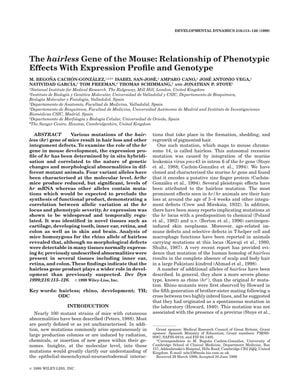The Hairless Gene of the Mouse: Relationship of Phenotypic Effects with Expression Profile and Genotype
October 1999
in “
Developmental Dynamics
”

TLDR Mutations in the hairless gene in mice affect its expression and lead to a range of developmental issues in multiple tissues.
The study from 1999 explored the hairless (hr) gene in mice, focusing on the relationship between mutations in this gene, its expression patterns, and the resulting physical characteristics. Researchers characterized four variant alleles of the hr gene and found that mutations led to reduced levels of hr mRNA or prevented the synthesis of functional protein, correlating with the severity of phenotypic effects. The hr gene was expressed in a variety of tissues, including skin, brain, cartilage, developing tooth, inner ear, retina, and colon, and was temporally regulated. Morphological analysis of mice with the rhino allele of hairless showed abnormalities in several tissues, suggesting the hairless gene has a broader role in development than previously thought. The study also found that the hairless mutation is caused by a proviral insertion, leading to aberrant transcripts and truncated proteins. The severity of defects in tissues like the eye, inner ear, and colon correlated with hr expression levels. Additionally, the study suggested that the Hr protein might regulate transcription of downstream genes and could be involved in responses to thyroid hormone. The research indicated that the hairless gene is crucial for the development and maintenance of various tissues, not just hair follicles.